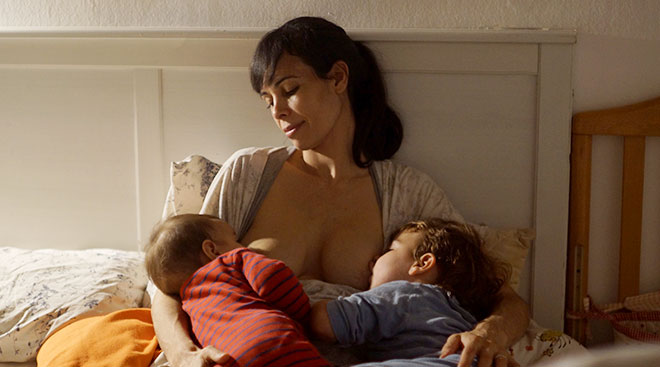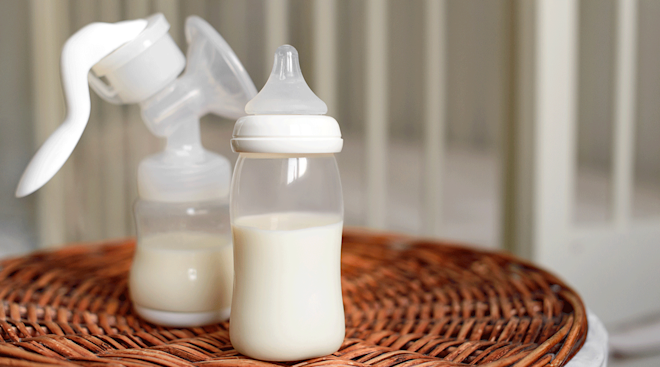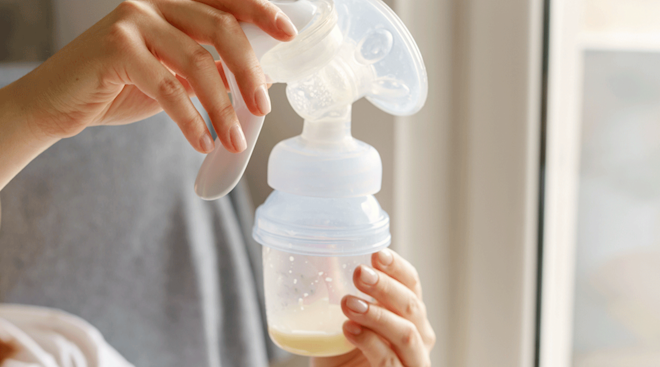Tips and Tricks for Tandem Nursing Two Kiddos at Once
Multitasking is part of the parenting gig. But when you have newborn twins or a baby and a toddler who are both nursing, the juggling act is even more pronounced. If you’re committed to breastfeeding your babies, you can try tandem nursing—which is pretty much exactly what it sounds like. Of course, learning to latch and feed your dynamic duo at the same time may take some patience, effort and flexibility (literally). Suffice it to say, it’s not the right path for everyone, and there will be some hurdles and hiccups along the way. But if you stay the course, it be can be an incredibly rewarding experience for you and your littles. Ready to get the lowdown on what it takes and how it works? Read on to learn more about the best tandem nursing positions, surprising benefits to feeding two at once and common challenges moms face as they balance it all.
Tandem nursing involves breastfeeding multiple kids at the same time. They could be the same age (usually twins) or different ages (one baby and one toddler). While tandem nursing typically involves breastfeeding two little ones, lactation expert Chrisie Rosenthal, IBCLC, says that this term can also refer to a parent feeding more than two children.
The components of breast milk change over time to meet baby’s evolving needs. Generally, new moms will first produce colostrum—a yellowish, nutrient-packed fluid—to serve as baby’s first food. A few days after birth, transitional milk will come in, followed by mature breast milk.
But if you’re already nursing a toddler, does your milk still cycle through these stages once baby arrives? According to Rosenthal, yes. Your body starts producing colostrum somewhere between the fourth and eighth month of pregnancy, she explains, and after three to five days, you’ll experience an increase in breast milk supply.
While colostrum is great for newborns, it does change the consistency and makeup of breast milk, so you may notice a change in your toddler’s feeding habits. “It’s common for breast milk supply to gradually decrease as colostrum increases,” says Rosenthal. “A breastfeeding toddler will often respond to this decrease in volume by increasing their breastfeeding frequency, [and] you may find that they’re hungrier for solids.” Colostrum can also act as a laxative, so your toddler will likely have more frequent, looser stools.
Tandem breastfeeding offers a variety of benefits, but the most obvious is that it’s a super-efficient way to feed two kids who are both nursing. Moreover, if you’re tandem feeding newborn twins, it ensures that they “remain on the [same] schedule, and allows for downtime in between [sessions],” explains Neela Sethi, MD, a pediatrician practicing in Valencia, California.
Tandem feeding a toddler and newborn offers other distinct benefits. Much like how breastfeeding helps a mom and baby bond, tandem nursing can help two siblings start to form a connection, explains Sethi. Plus, “tandem nursing can help your toddler ease into the transition of having a baby in the house and reduce [feelings of] jealousy,” says Jada Shapiro, CLSC, a doula and lactation expert in New York City.
Last but not least, having a toddler who nurses can help offset some of the common pain points you may encounter while breastfeeding a newborn. “Toddler feeders tend to help mothers get their milk in sooner after giving birth to a newborn,” says Sethi. What’s more, she explains that a toddler that tandem feeds can help relieve the pain of engorgement that many moms experience after birth, because they’re such “efficient” eaters. Plus, by nursing both a toddler and a baby, you’re removing more milk, which will, in turn, increase your milk supply, notes Shapiro.
Breastfeeding comes with an assortment of challenges; it’s hard enough to nurse one baby. But there are definitely a few extra hurdles unique to tandem-nursing moms. First, there’s often an adjustment period and a learning curve with tandem feeding. And don’t be surprised if you experience sore nipples or struggle to get enough food and water to keep your milk supply up while you’re just getting into the groove of things.
What’s more, while your milk supply may benefit from tandem feeding, it may initially dip for a while during pregnancy. So if you’re eagerly awaiting the arrival of a soon-to-be-nursing newbie, know that this may inadvertently affect your breastfeeding toddler; they may even begin to wean themselves, says Rosenthal.
Finally, across the board, experts note that parents who tandem feed often feel “touched out” from all of the nursing and cuddling they’re doing—so carving out some time and space for yourself is essential. And don’t feel guilty if you don’t love every moment of tandem nursing. It’s a demanding gig!
The good news: If you’re planning on tandem nursing a toddler and a newborn, you can feel confident that you already have the fundamentals of breastfeeding down pat; there likely won’t be as many surprises when a new baby joins the party. Still, there are some things that can help make the transition a little easier.
-
Latch baby first. Since toddlers can get their nutrition from a variety of sources beyond breast milk, you’ll want to prioritize baby’s access to your breast. For the first few weeks, make sure “baby gets first dibs,” says Rosenthal. They should have the option to feed at one breast or both. Get baby situated and give them time to settle and feed, then have your toddler sit, stand or kneel to position themselves around what works for you and your newborn.
-
Establish boundaries. Your toddler might protest that they have to share you with baby at first, so Shapiro recommends talking to them about when it’s okay to nurse and how to behave around baby. She also suggests getting your toddler a babydoll so that they can pretend to nurse too.
Tandem nursing twins can be overwhelming at first. Breastfeeding is never easy, and you’ve taken on double the challenge. So, first and foremost, show yourself kindness and grace as you get your footing.
-
Invest in a pillow. Before the babies arrive, get yourself a good breastfeeding pillow that’s designed specifically for twins. “If you don’t have the right support, you’ll have a harder time getting a good latch and holding both babies, and you may start feeling pain in your back, shoulders and neck,” says Rosenthal.
-
Have a second set of hands. Even with a pillow, getting two babies properly positioned can be difficult at first, so try to have a partner or another helper nearby to get the babies situated (at least until everyone gets the hang of it).
-
Latch one baby at a time. Rosenthal recommends letting the baby who has an easier time latching get started on feeding first so you can then shift your focus to help your other little one.
-
Get help. Tandem breastfeeding twins is hard any way you cut it. If you’re struggling, seek help from a lactation consultant, who can advise you on latch issues, positioning and any other challenges encountered.
Whether you’re nursing one baby or two, you’ll probably have to go through some trial and error to find the positions that work best for you. Of course, when you’re balancing more than one baby, it can be even more difficult to ensure everyone is comfortable and getting what they need out of each nursing session.
For parents who are tandem breastfeeding a toddler and newborn, Shapiro says basically “anything goes,” since toddlers can position themselves around the baby. In this case, parents just need to find what works so that both kids are safe and content.
Tandem feeding baby twins can be a bit trickier. Here are some tandem nursing positions you can try:
-
Double football. Sometimes referred to as “clutch,” this is when “a baby’s head is at the breast while their body is alongside the parent’s torso, tucked under their arm,” explains Rosenthal. Doing this with one baby on each side can give you more control; plus, it’s especially helpful for newborns with little or no head control.
-
Mix positions. Sethi recommends trying out a hybrid position: “Cross cradle one twin while football holding the other.”
-
Laidback breastfeeding. This tandem nursing position can give you a little break. Rosenthal suggests reclining with both babies lying diagonally across your torso to feed. Once your babies have good head control, you can also lay back and have each baby sit upright on either side of you.
-
Australian position. Once your twins are both able to sit upright, Rosenthal suggests sitting down with one baby straddling each of your thighs facing towards the breasts to nurse.
You’ll have to play around a bit to find which tandem nursing positions work best for you and your little ones. It may end up being some combination of positions that’s completely unique to you. As long as your babies are safe and fed (and you feel good), that’s all that matters.
About the experts:
Chrisie Rosenthal, IBCLC, is an international board certified lactation consultant and consultant relations manager at The Lactation Network. She received her bachelor’s degree from San Diego State University and her IBCLC certification from the University of California San Diego.
Neela Sethi, MD, is a pediatrician practicing in Valencia, California. She also serves as a MAM Baby Ambassador. Sethi earned her medical degree from the University of California at Los Angeles and completed her residency in pediatric and adolescent medicine at Cedars Sinai Medical Center.
Jada Shapiro is a doula, a certified lactation support counselor and founder of Boober, an online community offering lactation support to new parents.
Please note: The Bump and the materials and information it contains are not intended to, and do not constitute, medical or other health advice or diagnosis and should not be used as such. You should always consult with a qualified physician or health professional about your specific circumstances.
Plus, more from The Bump:
Navigate forward to interact with the calendar and select a date. Press the question mark key to get the keyboard shortcuts for changing dates.




















































